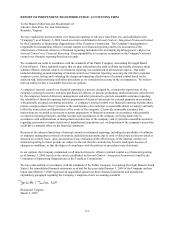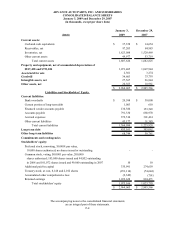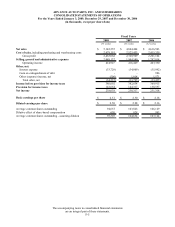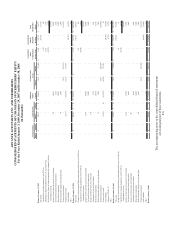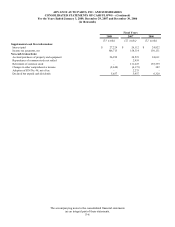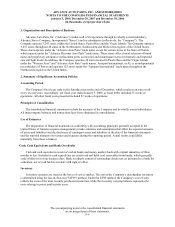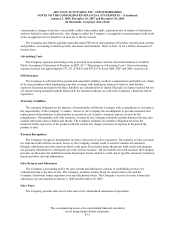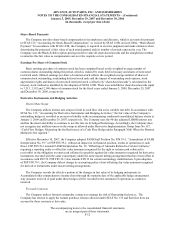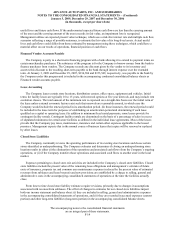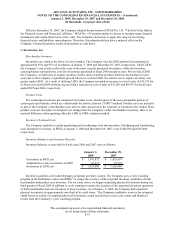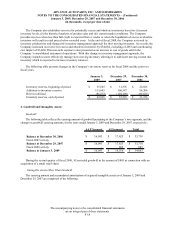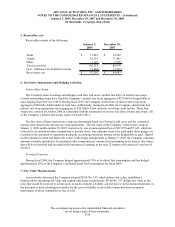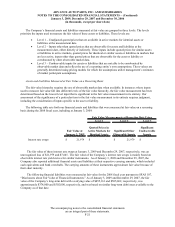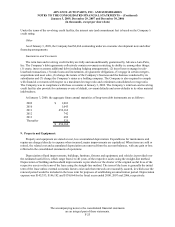Advance Auto Parts 2008 Annual Report Download - page 67
Download and view the complete annual report
Please find page 67 of the 2008 Advance Auto Parts annual report below. You can navigate through the pages in the report by either clicking on the pages listed below, or by using the keyword search tool below to find specific information within the annual report.ADVANCE AUTO PARTS, INC. AND SUBSIDIARIES
NOTES TO THE CONSOLIDATED FINANCIAL STATEMENTS – (Continued)
January 3, 2009, December 29, 2007 and December 30, 2006
(in thousands, except per share data)
The accompanying notes to the consolidated financial statements
are an integral part of these statements.
F-13
Accumulated Other Comprehensive Income (Loss)
Accumulated other comprehensive income (loss) is reported by the Company in accordance with SFAS No.
130, “Reporting Comprehensive Income.” The purpose of reporting comprehensive income is to report a measure
of all changes in equity of an enterprise that result from transactions and other economic events of the period.
Pursuant to SFAS No. 130, other comprehensive income refers to revenues, expenses, gains, and losses that are
included in comprehensive income but excluded from net income.
The Company’s Accumulated other comprehensive loss is comprised of the fair value adjustments of interest
rate swap transactions and the unrealized gain associated with the Company’s postretirement benefit plan.
Goodwill and Other Intangible Assets
In accordance with SFAS No. 142, “Goodwill and Other Intangible Assets,” the Company tests goodwill and
other indefinite-lived intangibles for impairment at least on an annual basis or if circumstances change that would
more likely than not reduce the fair value of a reporting unit below its carrying amount. Testing for impairment is a
two-step process as prescribed in SFAS No. 142. The first step is a review for potential impairment, while the
second step measures the amount of impairment, if any.
Under the first step, the Company compares the fair value of its reporting units with their respective carrying
amounts, including goodwill. If the fair value of a reporting unit exceeds its carrying amount, goodwill of the
reporting unit is considered not impaired and the second step of the impairment test is unnecessary. If the carrying
amount of the reporting unit exceeds its fair value, the second step of the impairment test must be performed to
measure the amount of impairment loss to be recognized, if any. An impairment loss would be recognized when the
fair value of goodwill or other intangible asset is below its carrying value.
The Company has elected to conduct its annual impairment testing as of the first day of its fourth quarter.
During fiscal 2008, the Company did not recognize any impairment to its goodwill or other intangible assets.
Valuation of Long-Lived Assets
The Company evaluates the recoverability of its long-lived assets under the provisions of SFAS No. 144,
“Accounting for the Impairment or Disposal of Long-Lived Assets.” SFAS No. 144 requires the review for
impairment of long-lived assets whenever events or changes in circumstances indicate that the carrying amount of
an asset might not be recoverable and exceeds its fair value.
Significant factors, which would trigger an impairment review, include the following:
• Significant decrease in the market price of a long-lived asset (asset group);
• Significant changes in how assets are used or are planned to be used;
• Significant adverse change in legal factors or business climate, including adverse regulatory action;
• Significant negative industry trends;
• An accumulation of costs significantly in excess of the amount originally expected for the acquisition or
construction of a long-lived asset (asset group);
• Significant changes in technology;
• A current-period operating or cash flow loss combined with a history of operating or cash flow losses, or a
projection or forecast that demonstrates continuing losses associated with the use of a long-lived asset
(asset group); and
• A current expectation that, more likely than not, a long-lived asset (asset group) will be sold or otherwise
disposed of significantly before the end of its previously estimated useful life.
When such an event occurs, the Company estimates the future cash flows expected to result from the use of the
long-lived asset (asset group) and its eventual disposition. These impairment evaluations involve estimates of asset


